|
Customizing
-- Green Lantern
by Matthew Jaycox
Here he is. The Granddaddy of them all. The figure that, if you want no
other customs, you want this one! I of course speak of none other than
the Emerald Avenger, Hal Jordan, the second, and still the coolest, Green
Lantern (save your letters, Alan Scott and Guy Gardner fans!).
I've gotten alot of requests for a How-To on this figure, but I've put
it off b/c it requires some tricky sewing that beginner readers of mine
probably weren't ready for. Now is the time though. This will be my last
Figure customizing article for a little while. Instead, future articles
will focus on such things as making accessories, specialty clothing items,
making your own packaging etc... Future figures from here on out in articles
may be chosen on the basis of how many requests I get for How-To on them.
E-mail me with your preferences. My complete list of all the customs I
have made will appear at the end of this article for you to refer to.
Back to G.L. This figure will dress up your collection in a way you just
don't realize until you see him standing with his other JLA counterparts.
Get him right, and Mego fans everywhere will think you are a genius. Plus,
on another level, we owe it to the guy to immortalize him since he appears
on the Hall of Justice playset decals.... especially since D.C. in their
all-seeing wisdom decided to have him leave D.C. universe continuity not
by retiring or dying gracefully in battle-- NO that would show too much
respect. They make him go crazy in a gender-bending rip-off of Marvels'
Dark Phoenix saga and then have him kill himself! What the hell is wrong
with D.C.?!? Every time they want to boost sales they kill or paralyze
someone (Robin II, Batgirl, Batman, Superman, Flash, Green Arrow, Green
Lantern), and usually someone whom I think is cool.
Now c'mon, let's give him the respect he deserves.
That said, let's get started!
Materials [HEAD]:
- A Sir Galahad/ Will Scarlet head
- Super Sculpey
- Acrylic modeling paints, flat
- Clay sculpting tools (stylus, smoother, prods)
- X-Acto knife
- needle point files and sandpaper
- Bondo auto repair plastic jelly
- A/B plumber's epoxy or Miliput [or Alumilite A and B resin with mold
release]
- Pam Cooking Spray
- Vaseline
- Lego Block mold box
Materials [costume]:
- Emerald green poly-interlock (spandex) fabric (flat green preferably)
Note: this farbric streches not only up/down but left/right as well, as
opposed to jersey which only stretches in one direction
- Black Spandex
- Tape measure
- Grey-Silver ribbon tape, approx 1/8" wide
- Sew on snaps
- Pins and needles
- Green thread
- Sewing machine and the skills to use it
- Flimsy white vinyl (for gloves)
- White sticker labels, circular, diameter approx 3/4"
- Green Markers, black felt tip pen
- Super Sculpey (for ring)
PROCEDURE:[Costume]
1) Take out the type II body you will use. Take your tape measure and
start making measurements, such as the arm length, inseam, length from
neck to crotch, length from neck to waste. Write these down and draw a
pattern as shown in (figure A). Add 1/8" seam allowance to all seams.
I have not given you the measurements, but that is how your pattern for
the torso should generally look (figs A+B). Most people can make the patterns,
they just don't know the order of the sewing, which is where I can help!
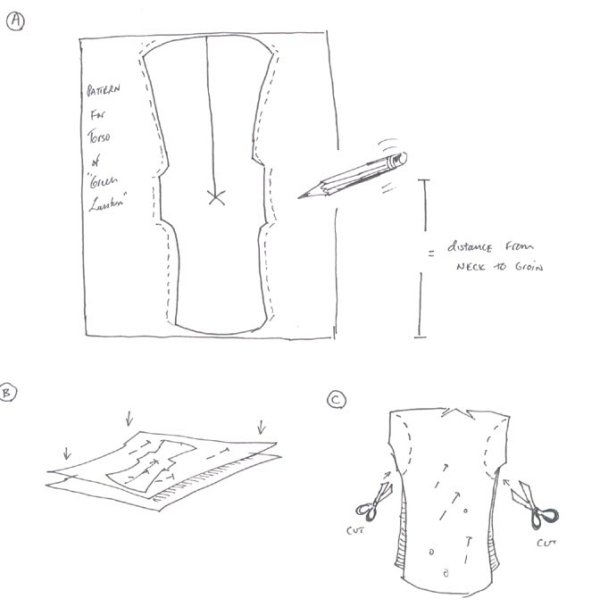
2) Lay your shirt pattern down on a single layer of Green fabric and pin
the pattern to the fabric. Cut out along the lines. Remove the pattern
and pins (fig. B). Fold the torso along a crease at where the shoulders
will be (fig. C). Cut out the 2 semi-circles as shown. Lay your green
torso down on a sheet of white paper, opening up the crease, and trace
along the cut line. Draw this out an appropriate length for the arm pattern.
Add 1/8" seam allowance (fig. D). Pin your pattern to a double-fold layer
of black fabric and cut along the pattern lines. You now have two matching
sleeves (figs. E+F).
3) Align the edge of your sleeve with the edge of the torso as shown in
(fig. G). Make sure both of the I-sides are facing you. Get ready, it's
time for some hand-stitching. Instead of screen printing on the black
of this costume (which is what I'm sure Mego would have done), we are
actually going to sew it on. But it is a tricky stitch, and a little complicated
for a sewing machine, so I'm going to save you all a headache and show
you how to do it by hand. It's very important to work very slowly when
handstitching and to be patient so as not to make mistakes.
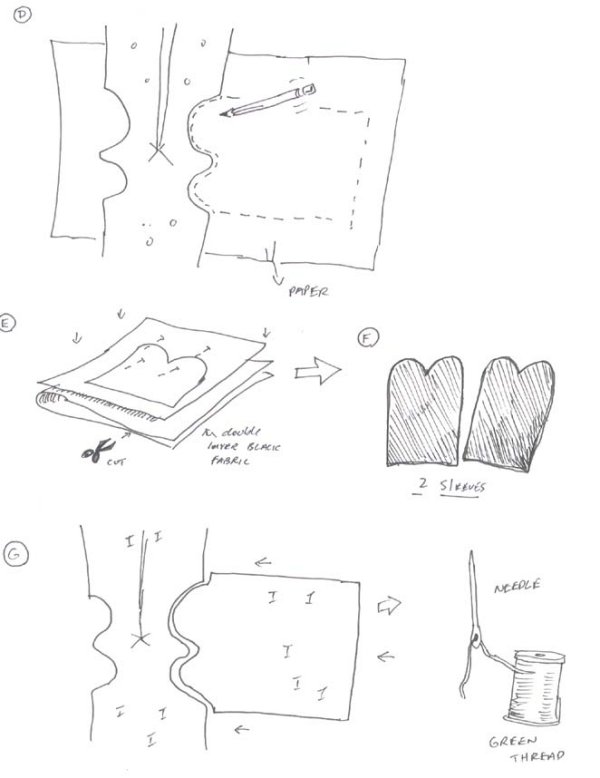
4) The type of stitch we are going to use is called a "quilt stitch."
This is very similar to a normal "loop-running stitch" which many of you
may know without actually knowing the name of it, however, with one slight
modification. With a quilt stitch, you stitch a loop, but before pulling
it closed, you begin another one and feed the end of the thread through
the previous loop, and then pull the loop closed. This ties off each individual
stitch and makes for a stitch that won't unravel on you and is very strong.
It also makes for a straight line across the top of the stitch. Refer
to (figs. H+I). So your two pieces of fabric are aligned as seen. I stick
the needle through the black first, then through the green (fig. H). My
thread has a knot in the end so it won't pull through. I make a loop away
from myself (fig. I.1), go back through the green, then the black, but
before pulling loop 1 closed, I feed the end of the thread through loop
1 (fig. I.1), and then pull it closed over the thread. (Figs. I.2-I.5)
details a series of quilt stitches. Again, the order of the stitch is:
Over, Back, Around, Through the loop, Pull closed. This is easily remembered
with the mnemonic; "Our Baby Always Talks Preciously..." Stitches should
be spaced about 1/16" a part and should begin about 1/8" below the edge
of the fabric. Keep your stitches small and tight or they will show dramatically
on the other side when the garment is turned right side out.
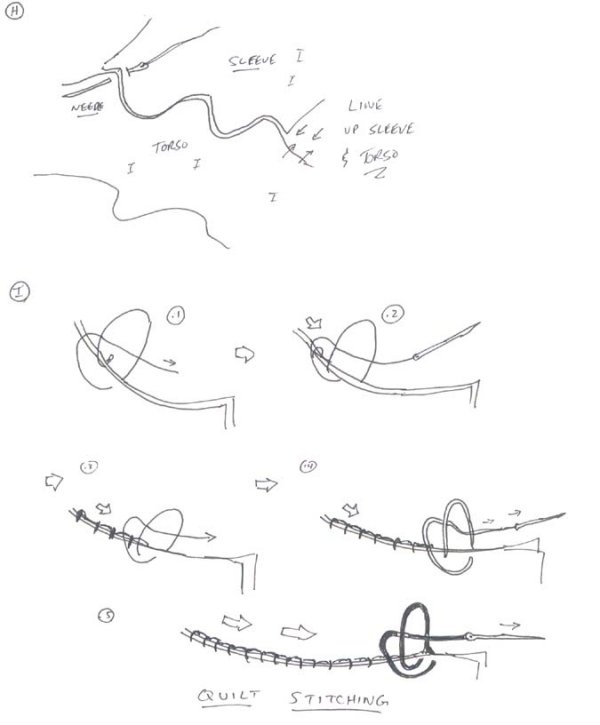
5) Okay, now you've stitched on both black sleeves. Now fold down the
hem of the neck and stitch it as shown in (fig. J) Fold back the hems
of the sleeves toward you and stitch them as well (fig. K). Repeat for
other sleeve.
6) Turn your torso inside out so all of the I-sides are facing you and
align the seams of the ribs and arms. Use pins to keep in place while
stitching from the wrists towards the hips (fig. L). Keep in mind that
Spandex STRETCHES, so it is okay to sew the arms narrower than the actual
size of the Megos arms. It will stretch and show off the musculature quite
nicely. Turn your garment right side out again and cut two right triangles
out of the lower corners on each side of the torso while it is pinned
in place (fig. M). Take along strip of black fabric that, when when folded
over, is enough to fit one leg inside. Lay your torso over the fabric
fold as shown in (fig. N) and cut the black fabric parallel to the leg
openings in the torso (fig. N). Repeat for the other leg.
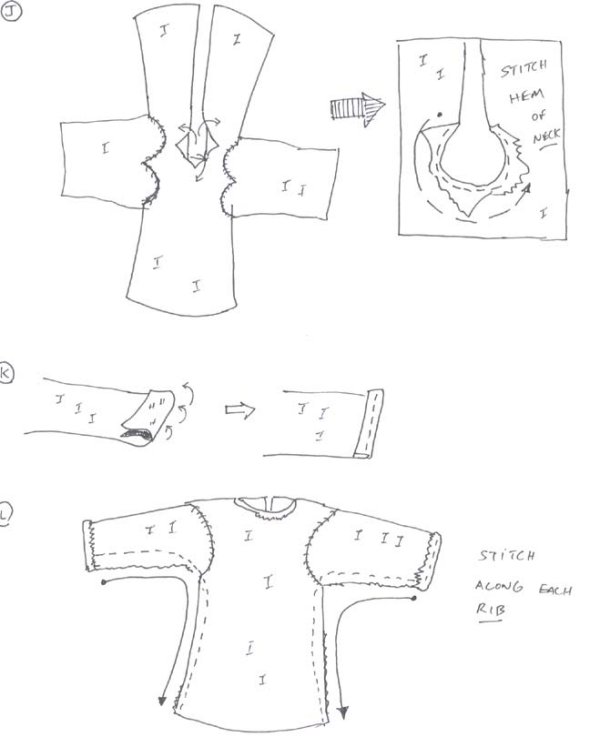
7) Turn your torso inside out again and with the I-side facing you, lay
it down on the opened up legging whose O-side was facing you. The legging
now resembles a long tower with a "roof." align the edge of the roof with
the appropriate edge on the trunk of the torso. Stitch one half, or one
"roof edge." Stitch the other "roof edge." Repeat fort he other leg (fig
O).
8) Stitch the crotch and legs partially closed. Only stitch each leg as
far down as mid thigh. See (fig. P). Cut off the excess black spandex
just below where the knee would be (fig Q). Cut a short strip of green
spandex the same width as the black. Turn the legs right side out so that
the O-sides of the legs are facing you. Align the edge of the green fabric
whose I-side is facing you with the edge of the black fabric leg (fig
R.). Stitch the green to the black (fig. R). Repeat for the other leg.
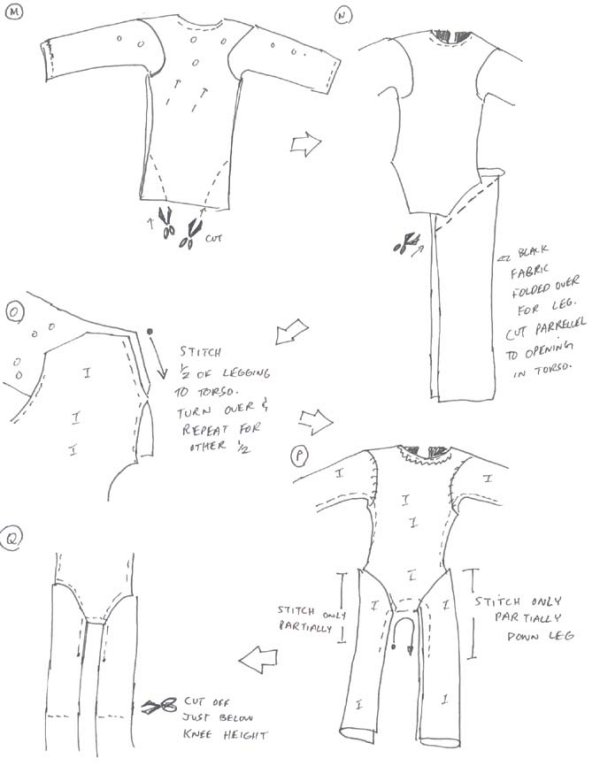
9). Turn your garment inside out again so that all of the I-sides are
facing you (fig. S). Stitch the legs closed but leave them open at the
end so that the leggings are like fabric "tubes" (fig. S). Turn the garment
right side out again and clothe your figure in it. Cut off the excess
amount of fabric in the feet/boots, but leave at least 1/8" for seam allowance
(fig. T).
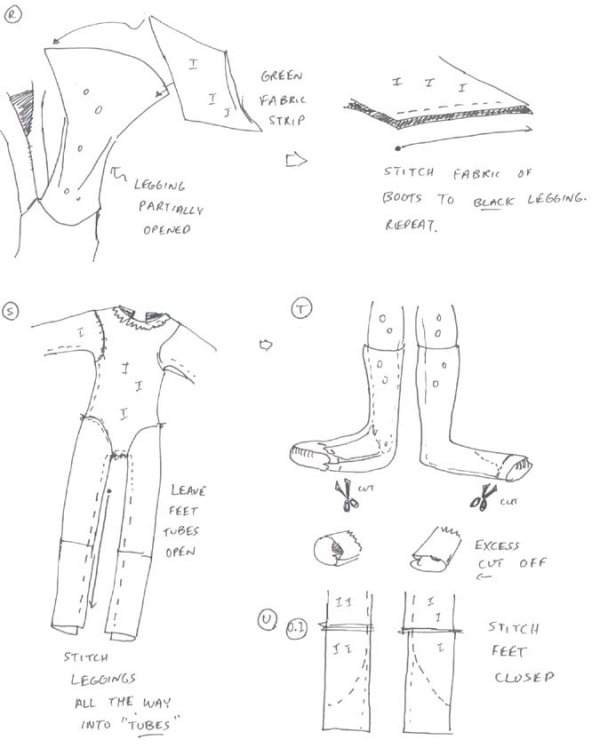
10) Turn the garment inside out again so that the I-sides
are facing you and stitch the feet closed as shown in (fig. U.1). Cut
away the excess. With your garment still I-side out, fold the hems of
the back toward you and stitch them as shown in (fig. U.2). (I wonder
if Bono would play with a Mego of himself...). Now stitch the back halfway
closed, from the butt to the middle of the back, taking up any excess
give in the fabric along the way so that it fits snugly. Sew snaps on
to the back near the top (fig. U.3).
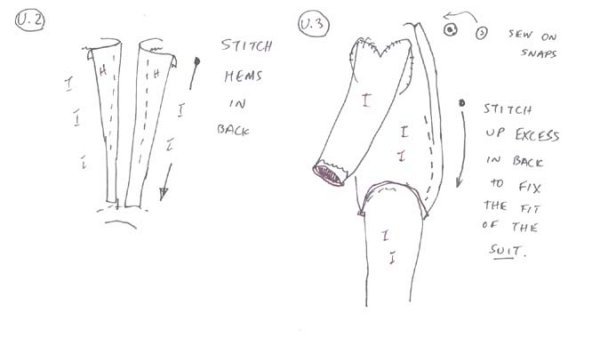
11) I make gloves as arm bands and then paint the hands,
much in the same way Mego did with Green Goblin. The gloves I made are
from flimsy white vinyl folded over and cut with a flair (fig. V.1). I
then glue the seam and presto, a nice vinyl glove! (fig. V.2). I use contact
cement to glue the gloves shut. Some people I know use a thin piece of
PVC tape of the same color as the vinyl and tape it along the seams. Either
way, it looks pretty good.
12) Making the insignia. You can do this a number of ways.
You can draw the insignia yourself on round stickers (fig. W), you can
color copy one out of a Green Lantern comic and glue it to his chest.
For those of you looking for the easy way, I have drawn you a pretty good
insignia right here (fig. W). Simply print this page. Now either Xerox
reduce or enlarge it until you've got your insignia to the desired size.
Now color it in with a green marker. Now take it to your local Kinkos,
or scan on your scanner and color print the sucker out. Color copy paper
is usually of sufficiently high enough quality for my tastes to use as
a sticker, however, if you want something a little more sturdy, place
your paper insignia between two layers of clear packaging tape. Then cut
out along the circle and you have a nice flexible laminated decal. Affix
this to the front of your costume using Elmers glue, a thin smear on both
the decal and the fabric itself. Press in place.I tend to place decals
on when the figure is actually wearing the costume, but place a bit of
masking tape over his chest under the garment so the glue doesn't bleed
through and glue to the garment to the figure.
13) The easiest way to make a ring if you don't want to sculpt
one out of Sculpt is to cut one using manicure scissors out of an only
margarine tub lid. You can get the hole in the center of the lantern ring
by pressing a needle through he plastic. (Fig. X). Now glue this to the
hand using cyanoacrylate glue. Allow to dry and then paint your hands
and ring. Note: You should paint the hand while the figure is dressed
in the costume but with the sleeves pushed up. This will keep you from
scratching off the paint when pull the costume on the figure. When dry,
place the gloves back on carefully. Your costume is now done!
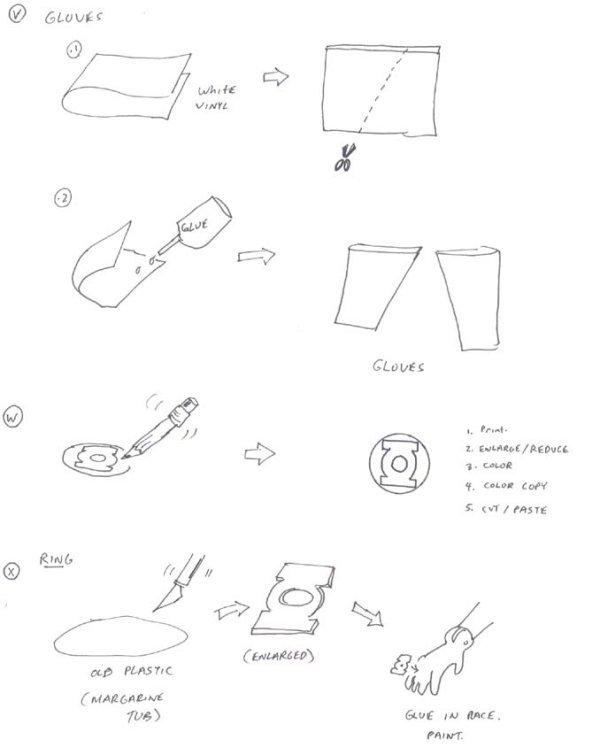
Onto the head!
PROCEDURE: [Head]
1) Get your hands on a Sir Galahad/Will Scarlet head. As
is often the case, this is the perfect base head for this figure. Some
people will swear by Superman, but I don't like him for this. As someone
pointed out, he looks like a young Hugh Hefner. Some people think Shazam
works (which I used as the mock-up model when posing this figure inside
his box. See photo), but I think his nose is too small and not enough
chin. Some have used Mr. Fantastic, but I don't like his sunken in cheeks.
Here are the reasons I used Will Scarlet as the base head. You are, of
course, free to use whatever base head you prefer.
- Has a great nose, eyebrows, eyes, and cheekbones
- Neck is nice and thick and heroic looking
- Easily alterable hairline
- perverse curiosity to see just how many customs I can make using him
as base head, a list which between Phil Noble and me includes characters
such as Bruce Banner, Namor the Sub-Mariner, Phantom Stranger, The Shadow,
Custom Zorro and now G.L.
Okay, so that's settled. Let's get on with it now shall we?
2) Make a 2-part mold of the head (fig Head A+B). Refer to
my previous articles on Dr. Doom or ,The Greatest American Hero for procedure.
Produce a copy.
3) Take out your files and X-acto knife and sand paper and
start filing away (Fig. Head C+D). You want to file down his hairline
and sideburns until he vaguely resembles Michael Milken sans hairpiece.
4) Roll out some small gobs of sculpey and lay them in thin
sheets onto his head. Using your finger to smooth over any imperfections.
At first, all you are trying to do is build up the general shape of the
hair (fig E). Use your fingernails, fingers, smoother or anything that
helps with this. Make sure you wiped all the dust off the head prior to
the application of sculpey, or it won't adhere. Smooth over the seams
where the Sculpey hair meets the actual hair of Will Scarlet. Now define
the edge of the hair with your X-acto blade. Add a small rope of Sculpey
for the spit curl (fig. F). Take your finger and with a quick, light wiping
motion, rub out any marks or fingerprints. Now take your sculpting prods
(or needles if you have none) and scrape some grooves into the hair. Imagine
the way actual combed hair looks. Mak the lines long and curvy and flowing
(Fig. F). To remove any final imperfections in the clay prior to baking,
paint a THIN smear of isopropyl alcohol over the clay with a SOFT paintbrush.
Alcohol is a polymer clay solvent and will remove things like fingerprints.
It may also, however, dissolve some of your hair grooves which you will
need to redefine. Blow on it gently to get the alcohol to evaporate more
quickly. Now place the whole kit'n'kaboodle in the over at 275 F for 12-15
mins. (fig. G). Allow to cool.
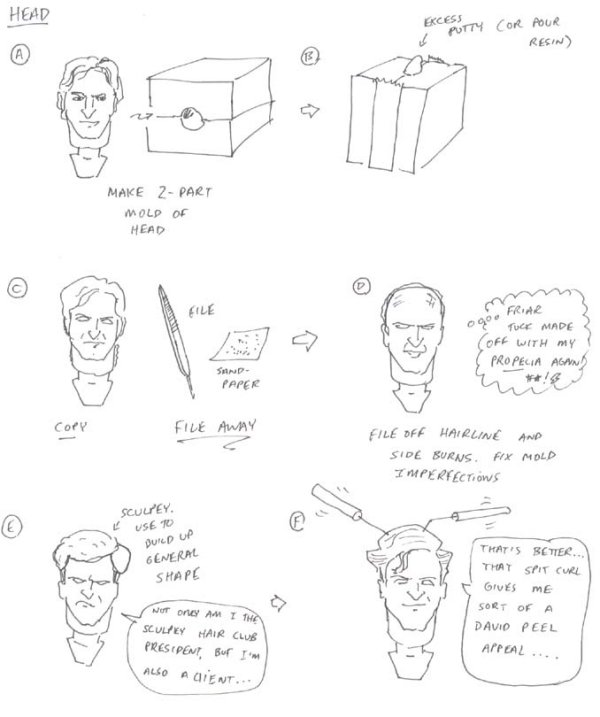
5) Now paint your head. I like to mount the head on the body
first before painting it (note, some filing down of the neck plug may
be necessary as it is now made of hard plastic as opposed to PVC). That
way, I don't ruin the paint job trying to force the head onto the body.
This should be done prior to the final clothing of the figure, and hence
painting of the hands and ring. I painted the head a base coat of flesh.
Then I painted the hair a base coat of light brown so that the grooves
on the hair would be lighter. I then painted the darker brown of the hair,
going at right angles to the direction of the grain of the hair, so that
the new paint wouldn't get in the lighter grooves, and now the grooves
would stand out. I painted a final coat of flesh, then the whites of the
eyes. Finally I painted in the green of the mask and the neck. (Fig. H).
I painted a clear coat of falt acrylic sealant on at the and to protect
the paint job as well as on the hands.
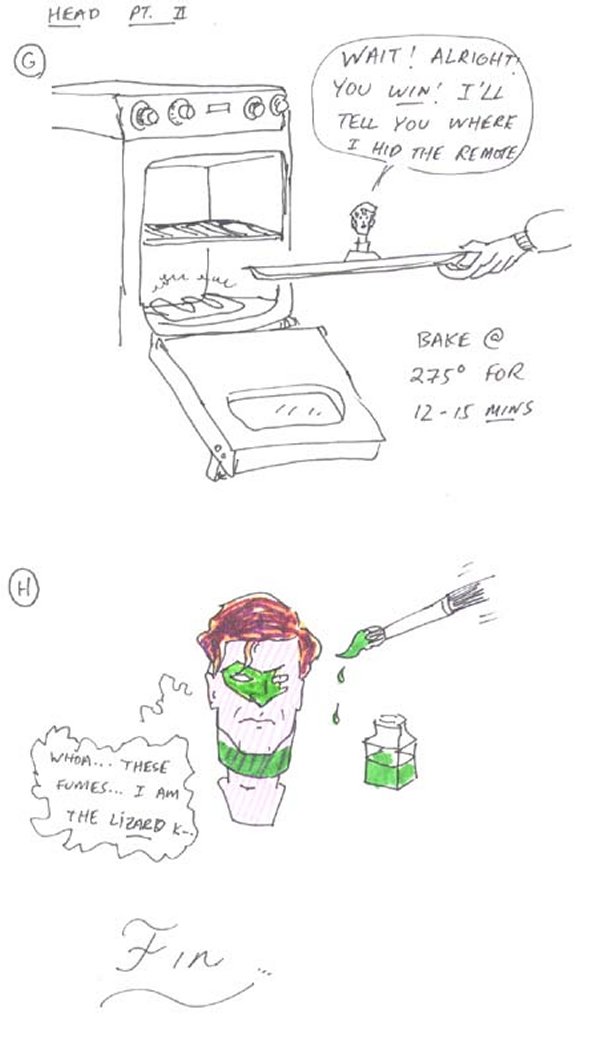
And voila, here is the final product. Incidentally, I gave
him more muscular arms from a LJN type body. Since the ball of the shoulder
is larger than the Mego type II body shoulder socket, he really looks
like he's got broad shoulders. Very heroic, don't you think? The lantern
is just a mini-Coleman key-chain lantern available in the camping departments
of most Wal-Marts and Meijers. I haven't gotten around to customizing
it yet to look Like Hal Jordan's Lantern. Someday soon though, with an
addendum to follow.
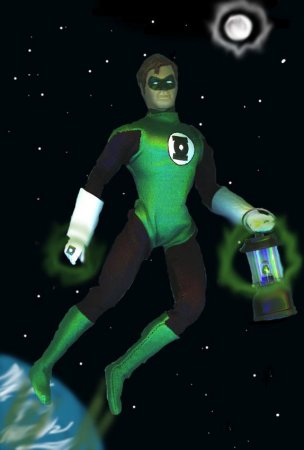 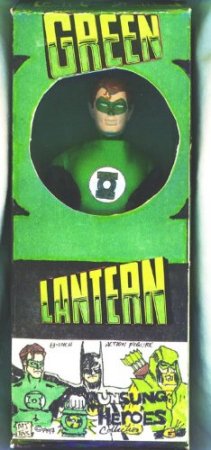
|



